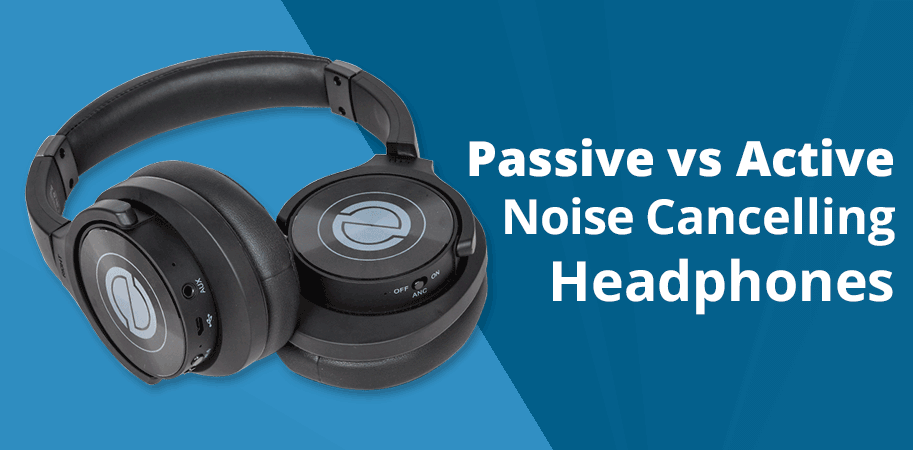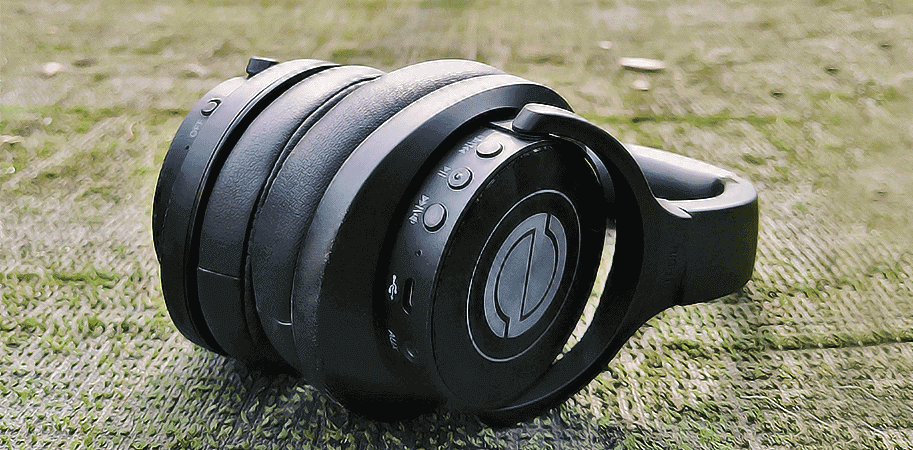

With the increased use of Smartphones, features like passive and active noise cancellation play a crucial role. Some people might suggest you a headphone with active noise cancellation for travelling, and some might also suggest a passive one. But, are they a feasible option?
If you are confused regarding the two headphones, then read this guide to know about it in detail. This guide explains how a noise-cancelling headphone works. Plus, it explains the difference between noise cancelling and noise isolating.
Contents
A] Passive Noise-Cancelling Headphones
1. What is Passive Noise-Cancelling Technology?
Passive noise-cancelling headphones help to block out the sound that is based on the physical ear cup design. More sound is blocked if the headphone sits in/on your ears perfectly, so it also depends on the make and brand you choose.
With passive noise cancellation headphones, the user is focused on the immersive sound experience. You’ll hear less unwanted ambient sounds with the feature. Passive noise cancellation headphones work on the mechanical designs of the ear cups that play a major factor in blocking the sound.
In order words, passive noise-cancelling headphones block out the sound waves from the environment with the physical materials that are used. It works like earmuffs that soften the noise. When your ears are completely covered by the headphone, you’ll not be able to hear any external sound.
2. The Features
Most headphones that come with passive noise cancellation feature have extra padding support that provides full comfort and great fit. When it draws out the sound of what goes around you, it lets you hear the music loud and clear.
The passive noise cancellation feature also works on certain frequencies from the ambient sounds. Some headphones might limit the frequency sound to 1 kHz. Passive ambient noise reduction means insulating the ears from the external noise. The feature works for higher and middle range frequencies. Passive noise cancellation headphones provide a great experience when the ear cups completely snuggle the ears without leaving a gap.
3. Why Should You Use Passive Noise-Cancelling Headphones?
Over-ear headphones, also known as the circumaural headphones, use the passive noise cancellation feature. Many models are available, so you can choose depending on your budget.
Being over-ear headphones, the ear cups are large. It entirely fits in the ears, leaving no extra space. The headphones completely seal the ears allowing the least amount of the ambient noise to seep in.
The headphones allow the reduction of the ambient noise, giving you a great music listening experience. It’s an ideal choice if you are into music mixing, or if you are an ardent fan of different music genres.
4. More About Passive Noise Cancellation
On-ear headphones also offer passive noise cancellation features, but the one offered by over-ear headphones is unmatched. The seal provided by over-ear headphone makes all the difference. It blocks the ambient sound giving you great-sounding music. Passive noise cancellation accounts for 99 percent of the noise reduction, which is good.
But, the feature also comes with a high price tag. So, you’ll have to shell out extra for the passive noise cancellation over-ear headphones that are available in the market.
Passive noise cancellation headphones do not require added power to work. They work on lesser power, and battery life is also good.
If you compare active noise cancellation vs passive noise cancellation technology, then the former one offers good power. Passive noise cancellation feature technology is also available in the in-ear and on-ear styles of headphones.
But, the seal and experience that over-ear headphones offer are excellent. It is also to do with the large cup size of the headphones. Passive noise cancellation headphones may work for you if you are ok with a huge headphone sitting on your head. It is mostly for people who also look for light-weighted headphones.
B] Active Noise-cancelling Headphones
1. What is Active Noise-Cancellation Technology?
Active noise-cancelling headphones use the materials and internal components to block the external noise by creating their sound waves. The sound waves mimic the external sounds by creating a mirror image and then cancel each other. Active noise cancellation also called (ANC) uses a microphone to monitor the environmental noise.
It creates an anti-noise feature that is mixed with your sound or audio playback that actively cancels the external noise. Most active noise-cancelling headphones come with digital or analogue filters. Active noise-cancelling headphones are battery-powered; its consumption depends on your use.
2. Filters
The filters are available in Feedback, Feed-forward, and Hybrid. It depends on the brand and feature of the headphone you use.
- Feedback Filter
In the Feedback filter, the mic is placed inside the ear cup and in the front of the speaker. Feedback filter can adapt to any variation in sound and correct the signal frequency. Feedback filter normally works on a broader frequency range as compared to the other two filters.
Even if you don’t wear your headphones correctly, the Feedback filter still plays an active role in blocking the ambient sound. At times, Feedback filters can also filter out the low-frequency sounds; but this may not affect your favourite music playback.
- Feed-Forward Filter
In the Feed-forward filter, the microphone is normally placed outside the ear cups. The person hears the noise later, the mic hears it first. After processing the external noise, it creates an anti-noise before it sends the signal to the headphone.
As the headphone mic picks up the noise in no time, it responds to early signals and generates anti-noise. If the headphone is not placed properly on the head, then the setup can amplify the noise, causing some kind of disturbance in music. The filter works with a narrow range of frequencies.
- Hybrid Filter
The Hybrid filter is a combination of Feedback and Feed-forward. It places the mic on outside and inside of the ear cups. Hybrid is good at suppressing the noise at a broader frequency range. It corrects errors irrespective of how the person wears the active noise-cancelling headphones.
The Hybrid filter has the right setup, so the results of the filter are good. But, if you compare noise isolating vs noise-cancelling headphones with this feature, then the latter one is expensive. Music lovers generally prefer Hybrid noise-cancelling technology for travelling in aeroplanes.
3. Why Should You Use The Active Noise-Cancelling Headphones?
This answers the question of how do noise-cancelling headphones work, but it is important to know about its use as well. Active noise-cancelling headphones can reduce up to 20 decibels of sound. It is a great choice if you are a frequent flier or if you travel a lot. It lets you hear your music on-the-go. Active design models can also reduce sound modules by up to 80 decibels.
The active noise-cancelling headphone is ideal for your office, music, or call. It perfectly blocks the ambient sound giving you the kind of privacy you need. The feature is available with on-ear, earbuds, and over-ear headphones. However, most people prefer over-ear headphone, as it provides a great noise cancellation because of its closed design.
#Noise-Cancelling vs Noise Isolating
Music lovers often get confused with the above two technologies. Is there a difference between noise isolation and noise cancelling? Yes, there is!
Noise isolation isolates external sounds and noises. It seals off your ear canals to provide you good sound clarity in music. It also depends on the type of headphone you choose.
Noise cancellation works on a structural design that acts as a barrier against external noises. It generates an anti-noise signal that usually cancels the extra noise giving you complete sound clarity. You’ll be able to listen to the sound clearly with this technology.
So, while both technologies provide similar features, the functioning is quite different.
#Active vs Passive Noise Cancelling Headphones – What Is Your Choice?
For a passionate music lover, listening to music is the most therapeutic experience. Investing in a great headphone that provides noise cancellation feature will give you an immersive music experience. The question is, which headphone is right for you?
Well, passive noise-cancelling headphones work with extra padding support that blocks the external sound. However, it blocks the sound only if you cover your ears with the headphone. Passive noise-cancelling headphones won’t work if the fit is not proper.
Active noise-cancelling headphone works on the ambient sound with anti-noise feature. It reduces the frequency of the sound, giving you complete clarity. It reduces the distractions of a noisy environment so that your sound is clear. Headphones with active noise cancelling feature can also cut off the aeroplane engine sound, so most fliers prefer it while travelling.
On a single tap, you’ll be able to activate the noise-cancelling feature in the headphone. It also allows you to listen to music on a lower level frequency, which is great. You do not have to crank up to calls or tunes to use the feature.
So, which to choose? Well, both technologies have their advantages, so pick a headphone that suits your needs.



No Comments